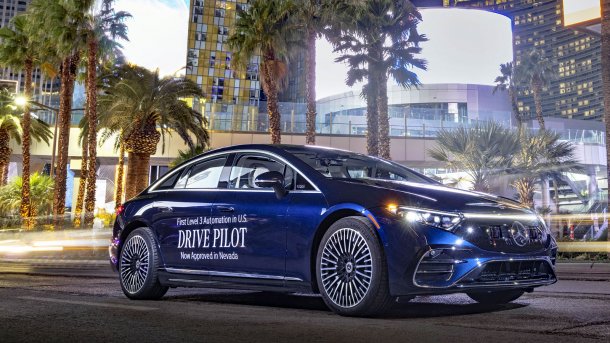Autonomous car: Mercedes "Drive Pilot" first Level 3 system with US certificate
Nevada allows Mercedes to use Level 3 automated driving, making "Drive Pilot" the world's first system with U.S. approval. Next destination: California.

The Mercedes EQS may drive autonomously in Nevada
(Bild: Mercedes)
(Hier finden Sie die deutsche Version des Beitrags)
Mercedes has become the world's first automaker to receive permission for highly automated driving to SAE level 3 for US road traffic in the state of Nevada. The system, called "Drive Pilot," will be available on the U.S. market as an optional extra for the S-Class and EQS models. Mercedes USA plans to deliver the first vehicles equipped with it "during the second half of 2023." Mercedes names the most populous U.S. state of California as its next target, still for 2023. The application has already been submitted to the relevant authorities, the company announced today.
The crux of readmission
Mercedes "Drive Pilot" meets the requirements in "Nevada Chapter 482A" for autonomous vehicles. SAE level 3 means temporary autonomous driving within a specific scenario. In it, the system masters longitudinal and lateral guidance. What is happening on the road does not need to be permanently monitored, but the person behind the wheel must always be able to intervene within a "sufficient period of time" if the assistance system is overwhelmed by the situation. The time for take-back is critical, as research shows that distracted drivers would need up to 10 seconds to take over and up to 15 seconds to be in full control of a traffic situation. This is also the time for the system to accept a readmission.
(Bild: VDA)
Limited to very concrete situations
"Drive Pilot" is limited to very specific situations. For example, it only works on public freeways at speeds of up to 40 mph (about 60 km/h) and only as long as the distance to the vehicle in front does not become too great. In addition to the route and traffic signs, the system also takes unexpected traffic situations into account and handles them, for example, by taking evasive action or, if that is not possible in the lane, by braking.
The sensors of the Driving Assistance package, which are standard in the S-Class, are used. Additional sensors such as LiDAR, microphones, a rear camera for detecting emergency vehicles and a wetness sensor in the wheel arch record enough data to enable a computer to provide orientation. In addition, there is a duplication of steering and braking systems as well as the on-board network. This is intended to keep the vehicle maneuverable in the event of a malfunction, enabling it to make a safe handover or achieve what is known as a "minimum risk state" with a standstill at the side of the road with the hazard warning lights on.
Centimeter-precise image of the surroundings
The precise position recognition required for autonomous driving is made possible by data collected by LiDAR, camera, radar and ultrasonic sensors with the aid of a continuously updated digital three-dimensional map with an accuracy in the centimeter range.
Markus Schäfer, member of the Board of Management at Mercedes, points out that his company sees the certification in Nevada as a beginning: "The certification in Nevada marks the start of the international market launch and thus the beginning of a new era in automated driving." At the end of 2021, the German Federal Motor Transport Authority granted system approval based on the technical approval regulation UN-R157, which was the prerequisite for further international approvals. In Germany, Drive Pilot has been available in the S-Class and EQS since May 2022.
(fpi)